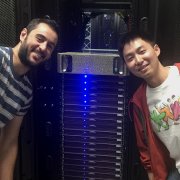CBMM is thrilled to be chosen as one of NVIDIA’s Pioneers of AI Research - NVIDIA Early Access selections. The Center has received one of the first deliveries of the groundbreaking new DGX-1 rack-mounted deep learning supercomputers that NVIDIA CEO Jen-Hsun Huang unveiled at the GPU Technology Conference 2016. To start, this unit will be shared with two other groups at MIT - Computer Science and Artificial Intelligence Laboratory (CSAIL) and the Laboratory for Information and Decision Systems (LIDS). Other institutions selected to receive a DGX-1 include UC Berkeley, Stanford, and the University of Oxford.
The DGX-1 is the first standalone system specifically designed for Deep Learning. In regards to this kind of research, this system will make it possible to try new and bold ideas, to understand how the brain processes the world around us, what we see, what we hear. The CBMM researchers working on Computer Vision, Speech Recognition, Computation Neuroscience, Brain Imaging, and more will all benefit from this amazing opportunity to use the DGX-1.
Typically, GPUs are hosted in a computer cluster where a bottleneck can occur transferring data back and forth from storage servers, memory, and the GPUs. Equipped with 8 state of the art GPUs with large on-board memory, the DGX-1 unit is a standalone system with none of these bottlenecks. This allows researchers to train larger, more complex models, which widens the type of science that the Center can perform. Previously, some models would be impossible to host on a single GPU, and for those that were possible, the iteration cycle of training and trying new ideas would be slow. The DGX-1 will dramatically improve how quickly we can train complex models with up to an 8X speed-up.
CBMM recently installed the DGX-1 at the Massachusetts Green High Performance Computing Center (MGHPCC.org) in Holyoke, MA where its 8 GPUs, connected via a first-of-a-kind NVLink Hybrid Cube Mesh, lots of RAM and disk space, and its heavy (140 lbs) 3U rack mount chassis will churn out vast amount of computing power to advance the research of the Center.
“We look forward to working closely with NVIDIA and to collaborate with them to make the most of this amazing new system. I’m excited to try the system and get around the data transfer bottleneck. The larger on-board memory will make it possible to try new, more complex models. I cannot wait to exploit data parallelism to reduce training time and try new ideas faster. The DGX-1 will make my research cycle faster which makes it more fun for me.”
– Andrea Tacchetti, MIT Graduate Student and CBMM Researcher

